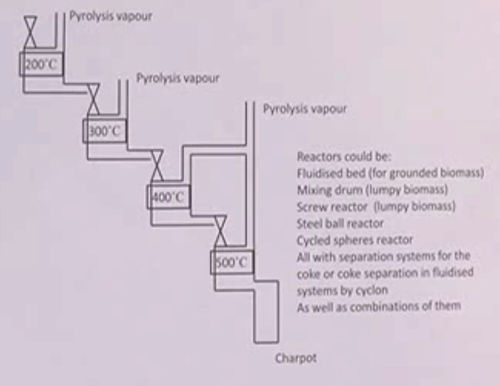Staged pyrolysis: Difference between revisions
m (inserted link: patent) |
No edit summary |
||
| Line 3: | Line 3: | ||
[[Pyrolysis]] is the thermal decomposition of organic matter under an inert atmosphere. Ligno-cellulosic biomass is a common feedstock. The process produces non-condensable gas, [[Pyrolysis Oil|bio-oil]] and [[biochar]]. The pyrolysis oil includes more than 300 valuable oxygenated compounds, such as furans, ketones, phenols and esters (see also: [[Biochemicals from Pyrolysis]]). Certain phenolic compounds are known for their insecticidal and fungicidal effects. | [[Pyrolysis]] is the thermal decomposition of organic matter under an inert atmosphere. Ligno-cellulosic biomass is a common feedstock. The process produces non-condensable gas, [[Pyrolysis Oil|bio-oil]] and [[biochar]]. The pyrolysis oil includes more than 300 valuable oxygenated compounds, such as furans, ketones, phenols and esters (see also: [[Biochemicals from Pyrolysis]]). Certain phenolic compounds are known for their insecticidal and fungicidal effects. | ||
Different constituents of [[Pyrolysis Oil|bio-oil]] can be difficult to separate. However, the composition of the off-gas is strongly influenced by temperature (see also: [[Wood Preservation by Carbonization]]). Therefore, when temperature is applied in different stages, different fractional components can be captured (hence: "staged pyrolysis"). | Different constituents of [[Pyrolysis Oil|bio-oil]] can be difficult to separate. However, the composition of the off-gas is strongly influenced by temperature (see also: [[Wood Preservation by Carbonization]]). Therefore, when temperature is applied in different stages, different fractional components can be captured (hence: "staged pyrolysis"). In other words, the value fraction from each step is improved and tar formation is minimized. | ||
==Example of Protocol== | |||
* 100°C to 250°C - [[torrefaction]] | |||
* 100°C to 250°C - pre-pyrolysis | |||
* above 350°C - [[pyrolysis]] | |||
==Video== | ==Video== | ||
Revision as of 23:24, 16 October 2017
Pyrolysis is the thermal decomposition of organic matter under an inert atmosphere. Ligno-cellulosic biomass is a common feedstock. The process produces non-condensable gas, bio-oil and biochar. The pyrolysis oil includes more than 300 valuable oxygenated compounds, such as furans, ketones, phenols and esters (see also: Biochemicals from Pyrolysis). Certain phenolic compounds are known for their insecticidal and fungicidal effects.
Different constituents of bio-oil can be difficult to separate. However, the composition of the off-gas is strongly influenced by temperature (see also: Wood Preservation by Carbonization). Therefore, when temperature is applied in different stages, different fractional components can be captured (hence: "staged pyrolysis"). In other words, the value fraction from each step is improved and tar formation is minimized.
Example of Protocol
- 100°C to 250°C - torrefaction
- 100°C to 250°C - pre-pyrolysis
- above 350°C - pyrolysis
Video
